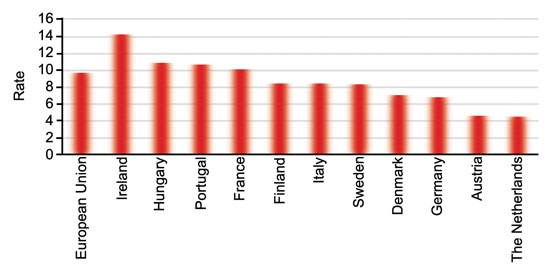
Attracting top workers is a full-time job in Germany
Machine vision manufacturer Basler AG is ramping up its hiring once again, reflecting an
economic rebound being experienced throughout most of Germany. The company, which
currently has about 250 employees, added five new people last year as the recent
downturn petered out. It expects to hire about 15 this year, mostly software engineers
and technicians.
Along with most of the rest of the world, Germany fell hard into
recession in 2008. By 2009, the last full year for which stats are up to date, the
country had an unemployment rate of 7.9 percent, up from 7.2 percent the previous
year, according to the federal statistics office (Statistisches Bundesamt Deutschland).
Compared with other economies, however, the dip was shallower and shorter. By September
2010, the unemployment rate had already fallen to 6.7 percent, much lower than the
9.6 percent average throughout the 27 members of the European Union.
 Germany’s employment rate is improving faster than in most
other EU nations. Data courtesy of Statistisches Bundesamt Deutschland.
Germany’s employment rate is improving faster than in most
other EU nations. Data courtesy of Statistisches Bundesamt Deutschland.
Poised for new growth, companies like Basler that are part of
the German photonics industry are trying to strengthen their ability to attract
and keep workers who are well trained and motivated.
Basler strives to keep existing employees, said Sabine Knüppel,
director of human resources and organization, by offering work/life balance and
similar programs. Throughout the country, she added, there have been both legislated
and unlegislated efforts to encourage people to stay in their careers. For example,
unmandated programs encourage young adults to start families and to help new mothers
maintain their careers. Knüppel noted one important law meant to help workers
stay focused on careers: Men or women can work zero hours or part time for up to
three years, with a return to their job guaranteed.
Other German photonics companies, such as laser maker Trumpf,
managed to escape the downturn without laying off any workers. Instead, the company
adopted the socially accepted model of reducing hours in lieu of letting people
go.
Technical education
The European Commission and other pan-European organizations have
called on members to have well-trained researchers who are ready and willing to
relocate to where the science and technical jobs are. Likewise, there are calls
for a robust research infrastructure and first-rate institutions of higher learning.
According to the 2010 UNESCO (United Nations Educational Scientific
and Cultural Organization) Science Report, most European universities run on the
principles of the Humboldt model, which presumes that academic training must involve
a minimum level of involvement in research. Unlike traditional European university
systems, this model practically guarantees that acquiring an advanced degree can
take many years.
Europe spreads its research resources thinly compared with the
US. According to UNESCO, European nations should foster greater diversity in many
areas, funding being one of them. This will require pushing universities to more
broadly define themselves as the equivalent of liberal arts colleges, offering separate
bachelor’s and master’s degrees. In most of Europe, however, students,
their families and employers don’t consider a bachelor’s degree to represent
a full university education, forming a cultural roadblock.
Nonetheless, such a shift is under way, and the traditional education
system in Germany is changing from master’s/bachelor’s equivalent (Dipl.)
to more US-like separate degrees, Basler’s Knüppel said.
While no national system for evaluating university research exists
in Germany, there is a concerted effort to foster university-level excellence in
science and technology education.
Germany’s Exzellenzinitiative (Excellence Initiative) is
the result of the country’s federal government working with the individual
states to broaden academic diversity. To promote the split degree system, the program
has identified 39 “excellent graduate schools” since 2005. Another component
of the initiative creates clusters (37 thus far), including one centered on nanosystems
based in Munich.
Germany also employs a dual-education system in which students
go to school part time while serving an apprenticeship for three to 3.5 years. Companies
such as Sill Optics GmbH & Co. KG in Wendelstein employ one apprentice for every
seven regular staff. “By the time they are finished,” Knüppel said
“the students are primed to stay at the company.”
Basler and Sill are generally happy with the level of education
provided their employees from both the university system and from Germany’s
technical schools. A problem in Germany for technical companies, Knüppel said,
is finding ways to engage a greater percentage of young students (grade-school age)
to aim for science and technology careers.
Basler works closely with local schools, through sponsorship of
“technology days,” providing projects and work groups as well as site
visits to the company’s facilities. Such school visits often try to engage
young women specifically.
There also is a Germany-wide “little inventors” competition,
designed to engage young minds. And Basler offers two- to three-week “little
internships” for 12- to 17-year-old students.
Other projects geared toward attracting young minds to science
and technology exist outside of industry and government. CyberMentor is designed
to draw more women into technical careers by getting girls interested in science
at a young age. Primarily an online community and resource geared toward girls aged
12 to 19, the program provides access to mentors.
/Buyers_Guide/Basler_AG/c1527